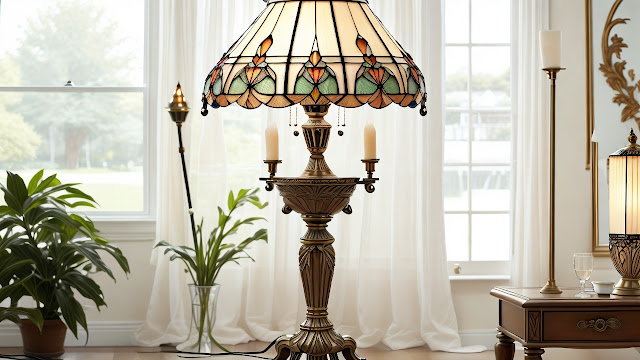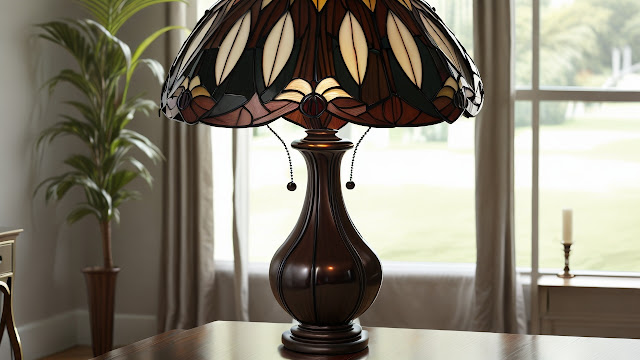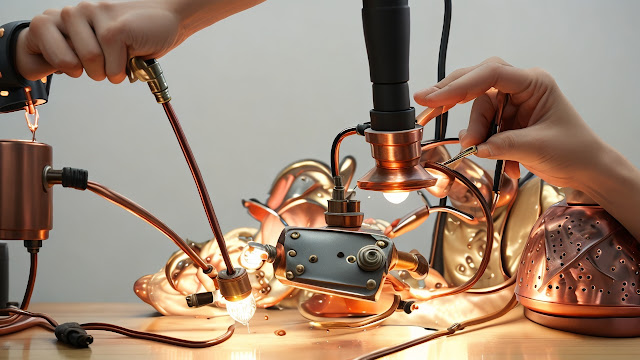Stained glass lampshades have an enduring charm that adds a touch of elegance to any space they adorn. These exquisite pieces of artistry are not just functional but also serve as a visual delight, casting vibrant patterns of light across the room. Have you ever wondered how these intricate stained glass lampshades are crafted? In this article, we will delve into the fascinating world of stained glass artistry, exploring the meticulous process of creating these beautiful lampshades. How Are Stained Glass Lampshades Made?
The Origins of Stained Glass
Before we dive into the production process, let's take a moment to appreciate the history of stained glass. Stained glass art has been around for centuries, with its origins dating back to ancient civilizations. It gained prominence in Europe during the Gothic era when stained glass windows adorned cathedrals and churches, depicting religious scenes with vibrant colors.
Gathering the Materials
1. Glass Selection
The first step in making stained glass lampshades is selecting the glass. Artisans carefully choose various types of colored glass, each with its unique hue and texture. This selection process sets the tone for the lampshade's final appearance.
2. Design and Pattern
Once the glass is chosen, a detailed design and pattern are created. This design serves as a blueprint for the lampshade, determining the placement of each piece of glass and the overall aesthetic.
Cutting and Shaping the Glass
3. Glass Cutting
Artisans then cut the chosen glass pieces into the desired shapes, following the design's outline precisely. This requires precision and skill to ensure that the pieces fit seamlessly together.
4. Glass Grinding
After cutting, the edges of each glass piece are ground to remove any sharp edges and create a smooth surface. This step ensures safety and enhances the lampshade's overall quality.
Assembly and Soldering
5. Copper Foiling
To join the individual glass pieces together, copper foil is applied to the edges. Copper foil not only helps in bonding the pieces but also adds an attractive outline to each glass element.
6. Soldering
Soldering is a crucial step where the copper-foiled pieces are carefully joined together. Skilled artisans use soldering irons to create secure connections, ensuring the lampshade's durability.
Finishing Touches
7. Patina Application
After soldering, a patina is applied to the lampshade to give it an aged or antique appearance. This step adds depth and character to the piece.
8. Cleaning and Polishing
The lampshade is then meticulously cleaned and polished to bring out its brilliance. This step is essential for enhancing the colors and shine of the glass.
Adding the Fixture
9. Fixture Attachment
To make the lampshade functional, a fixture is attached. This fixture includes the socket, wires, and a base. The lampshade is secured to the fixture, making it ready for illumination.
Quality Control
10. Inspection
Before the stained glass lampshade is ready for market or personal use, it undergoes a thorough inspection. Artisans check for any defects, ensuring that it meet the highest quality standards.
What are Stained Glass Lamps Called?
Can you stain glass at home?
Stained glass is a beautiful and artistic way to create decorative pieces like windows, lamps, and ornaments. Here are the basic steps to get you started on staining glass at home:
Gather Your Materials:
- Glass sheets: You can purchase clear or colored glass sheets from craft stores or online.
- Glass cutter: This tool is used to cut the glass into your desired shapes.
- Copper foil tape: It's used to wrap around the edges of the glass pieces.
- Soldering iron: To join the pieces together with solder.
- Solder: The soldering iron melts this material to create strong connections.
- Glass grinder: Helps smooth the edges of the glass pieces.
- Safety gear: Wear safety glasses and gloves to protect yourself.
Design Your Pattern:
- Plan your design on paper or use a pre-existing pattern.
- Keep in mind that stained glass designs often consist of many individual pieces.
Cut and Shape the Glass:
- Use the glass cutter to cut the glass pieces according to your design.
- Smooth the edges with the glass grinder to remove any sharp edges.
Wrap with Copper Foil:
- Apply copper foil tape to the edges of each glass piece. This will allow the solder to adhere to the glass.
Assemble the Pieces:
- Arrange the glass pieces according to your design, ensuring they fit together like a puzzle.
- Use the soldering iron to melt the solder onto the copper foil, joining the pieces together securely.
Clean and Finish:
- After soldering, clean the stained glass piece to remove any flux residue or fingerprints.
- You can add patina to give your project an aged look, if desired.
Polish and Display:
- Polish the stained glass with a glass cleaner to make it shine.
- Your stained glass creation is now ready to be displayed, whether as a window panel, lampshade, or decoration.
Remember that stained glass art can be a challenging craft to master, so it may take some practice to achieve your desired results. Additionally, always prioritize safety by wearing the appropriate protective gear, especially when working with glass and soldering equipment. Enjoy your creative journey into the world of stained glass crafting!
What is the difference between LED light and stained glass?
LED lights and stained glass are fundamentally different in terms of their nature, purpose, and characteristics. Here are the key differences between the two:
Nature and Composition:
- LED Lights: LED stands for "Light Emitting Diode." LED lights are electronic devices that emit light when an electric current passes through them. They are typically made of semiconductor materials and do not have physical shapes or designs. LED lights are available in various colors and are often used for illumination in a wide range of applications.
- Stained Glass: Stained glass refers to colored glass pieces that are used in artistic and decorative applications. Stained glass is made by adding metallic salts to the glass during its production, which creates vibrant colors and patterns. Stained glass pieces are assembled together to form intricate designs, often found in windows, lamps, and decorative panels.
Purpose:
- LED Lights: LED lights are primarily used for providing artificial lighting in homes, offices, streetlights, electronic displays, and various other practical applications. They are designed to emit light efficiently and are known for their energy efficiency and long lifespan.
- Stained Glass: Stained glass is primarily used for artistic and decorative purposes. It is not used as a primary source of illumination but rather as a way to add beauty, color, and artistic expression to spaces. Stained glass is often found in churches, cathedrals, historic buildings, and decorative objects like lamps and panels.
Functionality:
- LED Lights: LED lights are functional light sources that can be turned on and off, and their intensity can often be adjusted. They provide consistent and uniform illumination.
- Stained Glass: Stained glass, on the other hand, does not emit light on its own. It relies on external light sources (natural or artificial) to shine through it and create its mesmerizing and colorful effects. Stained glass pieces are static and do not change their appearance unless the lighting conditions change.
Aesthetic and Artistic Value:
- LED Lights: LED lights are valued for their practicality, energy efficiency, and versatility in lighting design. They are often chosen for their ability to provide specific lighting effects but are not considered artistic objects themselves.
- Stained Glass: Stained glass is highly regarded for its artistic and aesthetic value. It is crafted to create intricate patterns, vibrant colors, and storytelling designs. Stained glass pieces are often considered works of art and are appreciated for their beauty and symbolism.
In summary, LED lights and stained glass serve very different purposes and have distinct characteristics. LED lights are practical light sources, while stained glass is a form of artistic expression and decoration. Each has its unique place in various applications, with LED lights providing illumination and stained glass adding beauty and artistic flair to spaces.
Why are stained glass lamps so expensive?
Artistry and Craftsmanship: Stained glass lamps are often handcrafted by skilled artisans who invest a significant amount of time and effort into their creations. Each lamp requires meticulous attention to detail, from designing the pattern to cutting and assembling the glass pieces. The craftsmanship involved in creating these lamps is a time-consuming and labor-intensive process, contributing to their high cost.
Quality Materials: High-quality stained glass lamps are made from premium materials, including specialized glass sheets that are chosen for their color and texture. Additionally, they use top-grade copper foil or leading for construction and solder for joining the pieces. These quality materials ensure the lamp's durability and vibrant appearance, but they can also drive up the cost.
Complex Designs: Stained glass lamps often feature intricate and complex designs with numerous individual glass pieces. The more intricate the design, the more time and skill it takes to create. Additionally, the complexity of the design can require a higher number of glass sheets and colors, increasing material costs.
Customization: Many stained glass lamps are custom-made to suit the preferences of the buyer. Customization involves additional design work and adjustments to meet the client's specifications, which can add to the overall cost.
Limited Production: Some stained glass lamps are produced in limited quantities or as unique, one-of-a-kind pieces. This exclusivity can drive up the price, as collectors and enthusiasts are often willing to pay a premium for rare or unique designs.
Artistic Value: Stained glass lamps are not just functional lighting fixtures; they are also considered works of art. The artistic value of these lamps can significantly impact their price, as collectors and art enthusiasts are willing to invest in pieces that are aesthetically pleasing and showcase craftsmanship.
Historical Significance: Antique or vintage stained glass lamps, particularly those created by renowned artists like Louis Comfort Tiffany, can be exceptionally valuable due to their historical significance. Their rarity and historical importance can drive prices up significantly.
Handmade vs. Mass-Produced: While some stained glass lamps are mass-produced, high-quality and artisanal lamps are often handmade, which adds to their cost. Handmade lamps are unique and carry the mark of the artisan's skill and creativity.
Transport and Installation: Stained glass lamps can be delicate and require careful transport and installation to prevent damage. These additional considerations can add to the overall cost.
Time-Consuming Process: Creating a stained glass lamp is a time-consuming process that involves several stages, including design, glass selection, cutting, assembly, soldering, and finishing. Artisans often invest a substantial amount of time in each lamp to ensure precision and quality. This extended production timeline can contribute to the lamps' higher cost.
Skill and Expertise: Crafting stained glass lamps requires a high level of skill and expertise. Artisans who specialize in stained glass must undergo extensive training and accumulate years of experience to master the craft. The expertise of these artisans adds value to the final product and justifies the higher price tag.
Unique Designs: Many stained glass lamps feature unique or custom-designed patterns. These one-of-a-kind designs can only be found in a specific lamp, making them exclusive and desirable for collectors and enthusiasts. Such uniqueness often commands a premium price.
Appreciation of Art: Stained glass lamps are often purchased not only as functional lighting but also as a form of art that enhances the aesthetic appeal of a space. Buyers appreciate the artistic beauty, intricate detailing, and the way these lamps transform the ambiance of a room, and they are willing to invest accordingly.
Historical and Cultural Value: Some stained glass lamps hold historical or cultural significance, either because of their age or their connection to a particular era or artistic movement. These lamps can be seen as valuable artifacts, and their price reflects their historical importance.
Collectibility: Stained glass lamps have gained popularity among collectors. Rare or vintage pieces can appreciate in value over time, making them attractive investments. Collectors are often willing to pay a premium for well-preserved or sought-after stained glass lamps.







.jpg)
.jpg)
.jpg)



.jpg)
0 Comments